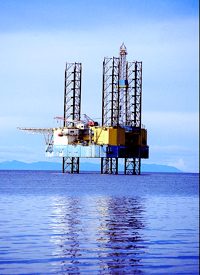
If oil industry discoveries continue at this year’s current pace, 2009 will see the highest number of new finds in nine years.
According to the September 23 New York Times, “More than 200 discoveries have been reported so far this year in dozens of countries, including northern Iraq’s Kurdish region, Australia, Israel, Iran, Brazil, Norway, Ghana and Russia.” IHS Cambridge Energy Research Associates notes that these new discoveries amounted to approximately 10 billion barrels in the first half of the year alone.
These finds all across the globe resulted from large capital investments in new technologies when prices rose earlier in the past decade. Oil rigs can now drill deeper and penetrate tougher layers of rock than ever before.
“That’s the wonderful thing about price signals in a free market — it puts people in a better position to take more exploration risk,” said Anadarko Petroleum Chairman and Chief Executive James Hackett. Of course the reverse is also true, and the lower oil prices fall, the less incentive there is to seek out new deposits. The Times noted that many oil industry executives “have warned that they need prices above $60 a barrel to develop the world’s more challenging reserves.”
The chief executive of Italy’s oil giant Eni, Paolo Scaroni, pointed out: “The appetite for opening new frontiers when prices were low in the 1990s was very small. Today, the biggest discovery of all is technology.”
When this new technology is applied to those “more challenging reserves,” the rewards can be great. Earlier this September, BP hit a huge deep-water oil field that may prove to be the largest oil discovery ever found in the Gulf of Mexico. Anadarko has announced a very significant find just off Sierra Leone in an “exciting and highly prospective” region.
Sometimes the smaller oil companies strike it big. Heritage Oil found almost two billion barrels of oil in the Miran West One field in Iraq’s Kurdistan region. This is one of 2009’s largest discoveries, and it has prompted Heritage to plan for another well there by year’s end.
Closer to home for Americans is BP’s previously mentioned Gulf of Mexico find in what is known as the Tiber field. BP has estimated that the Tiber field contains four to six billion barrels of oil and gas. This is theoretically enough to meet U.S. needs for more than a year.
“In 30 years I’ve been in the business, the Gulf of Mexico has been called the Dead Sea countless times,” said Bobby Ryan, Chevron’s vice president of global exploration. “And yet it continues to revitalize itself.”
This is the promise of American ingenuity and technology. The United States could drastically reduce its dependence on foreign oil if only more areas were opened to drilling. As the record-setting discoveries of the past months indicate, there are gushers just waiting to be found.



